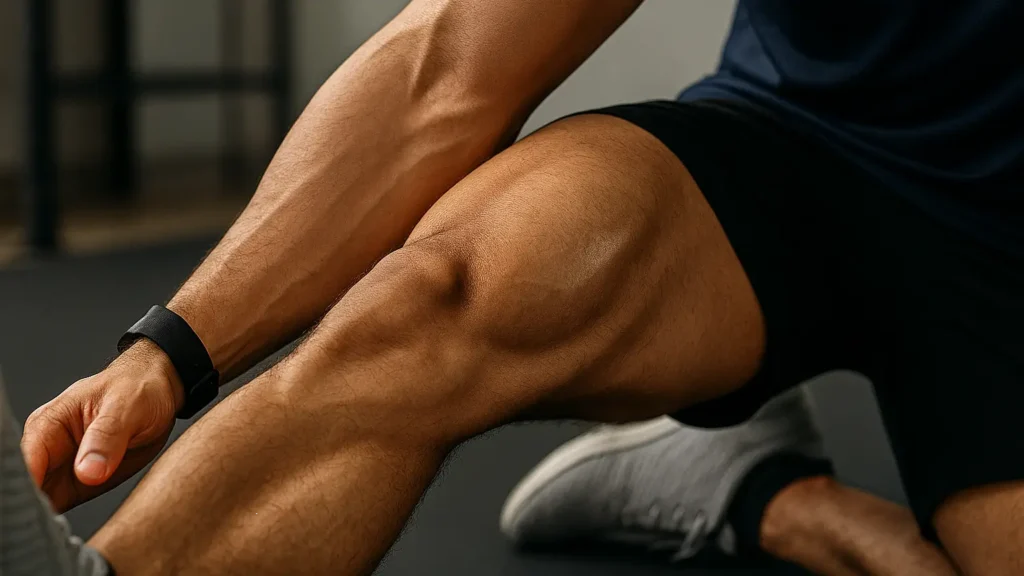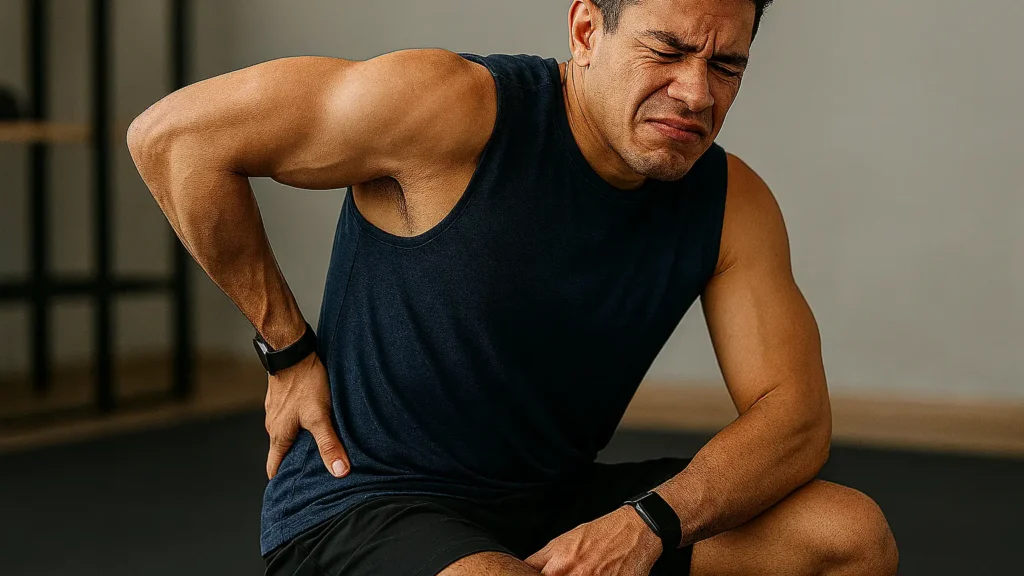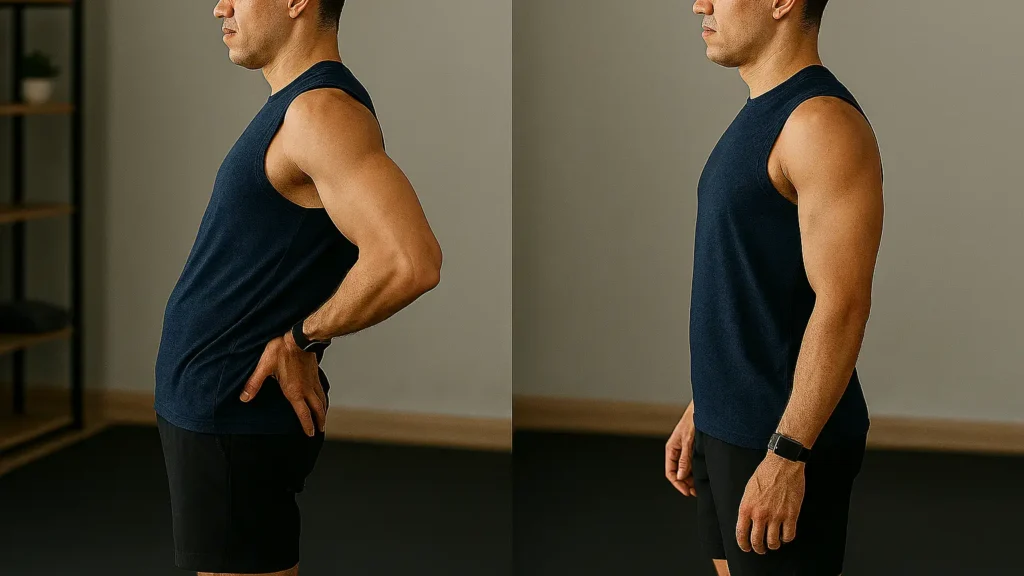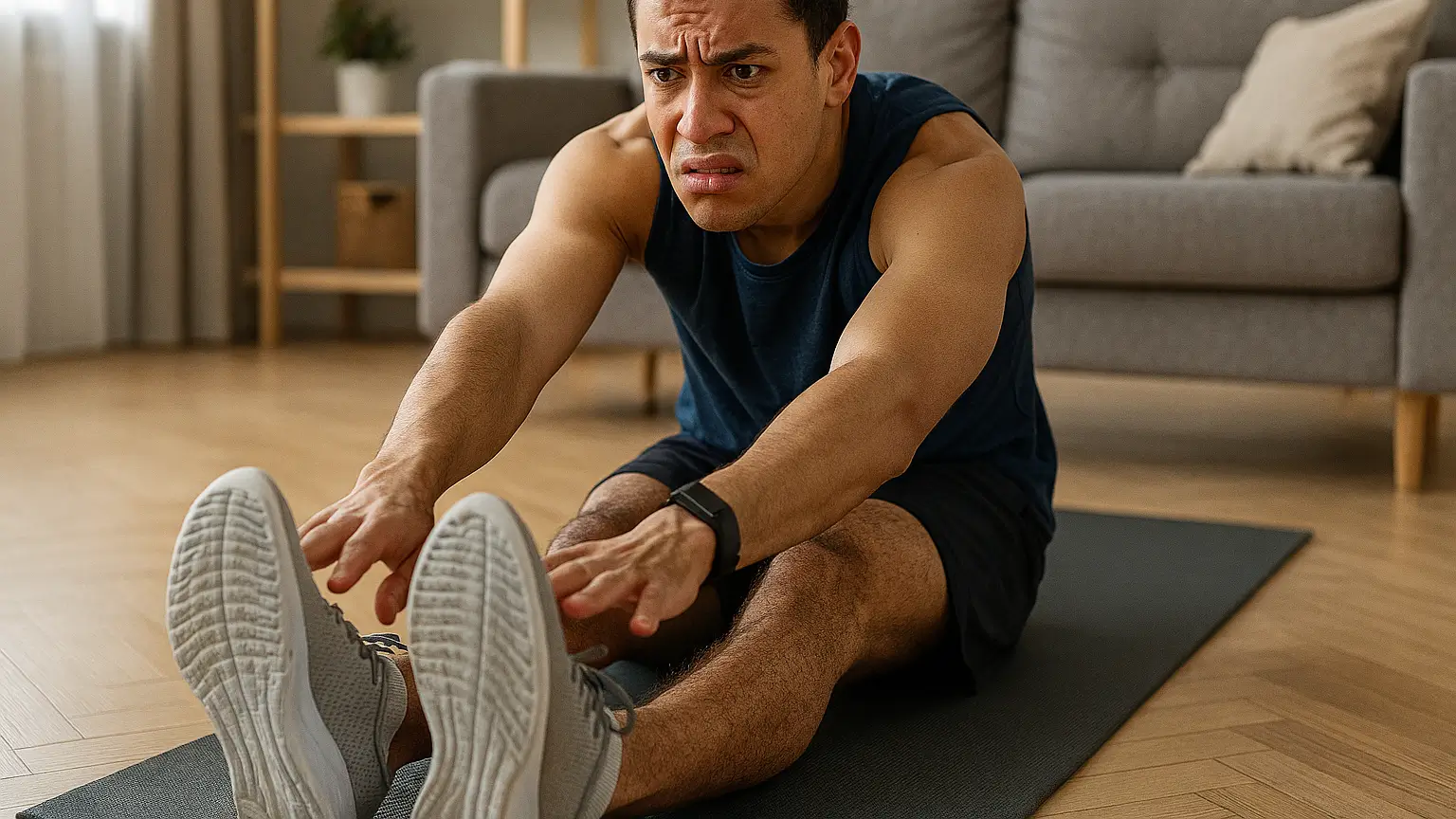“Why are my hamstrings so tight?” If you’ve ever asked this question after stretching diligently with no results, you’re not alone. Many people report that no matter how much they stretch, their hamstrings don’t seem to get any looser. This frustrating experience is especially common among athletes who participate in running or jumping sports.
Hamstring tightness occurs when the muscles on the back of your thighs become shortened due to various factors. However, the real surprise? Your tight hamstrings are typically not the problem themselves but rather a symptom of other muscles not doing their job properly. In fact, this tightness is often a combination of several factors, including prolonged sitting, which shortens the hamstrings over time, and muscle imbalances throughout your body. Additionally, when chronically tight hamstrings pull on your pelvis, they can create a domino effect of tightness in surrounding muscles.
Despite what many believe, stretching alone isn’t always the solution. An often overlooked cause of tight hamstrings is actually weak core muscles and weak glutes leading to overuse and tension in the hamstrings. Understanding these hidden causes is crucial for finding effective relief.
In this article, we’ll explore the true reasons behind your tight hamstrings and reveal the approaches that actually work to resolve this common problem for good.
Tight vs. Short Hamstrings: What’s the Difference?

Many people confuse tight hamstrings with short hamstrings, yet these conditions differ significantly. Tight hamstrings refer to muscles experiencing increased tension while maintaining normal length. Short hamstrings, conversely, have physically shortened over time through adaptations in muscle fibers.
How your brain controls muscle tension

Your nervous system plays a crucial role in regulating muscle tension. The brain continuously sends signals to your muscles, determining how much they contract or relax. This neurological component explains why stretching alone often fails to resolve hamstring tightness.
Interestingly, muscles tighten as a protective mechanism. Whenever your body perceives instability or weakness elsewhere, it creates tension in supporting muscles. For instance, weak core muscles might cause your hamstrings to tighten as they attempt to stabilize your pelvis and lower back. Furthermore, stress and anxiety can trigger your sympathetic nervous system, leading to increased overall muscle tension throughout your body.
Why one leg may feel tighter than the other
Asymmetrical hamstring tightness commonly occurs because of daily habits and movement patterns. Right-handed individuals typically experience tighter hamstrings on their dominant side. Moreover, activities like driving or consistently crossing the same leg while sitting create imbalances over time.
Underlying factors such as leg length discrepancies, pelvic misalignments, or previous injuries also contribute to one-sided tightness. Your body naturally compensates for these imbalances, causing certain muscles to work harder and become tighter than others.
When tightness becomes chronic
Occasional hamstring tightness usually resolves with rest and gentle stretching. Nevertheless, chronic tightness develops when the underlying causes remain unaddressed. Over time, your body adapts to this heightened tension state, making it feel normal even though it’s problematic.
Chronically tight hamstrings eventually alter your movement patterns. Your body creates workarounds to accommodate the tightness, leading to compensatory movements that can strain other areas. Subsequently, this cascade effect explains why tight hamstrings often correlate with back pain, knee issues, and reduced athletic performance.
The distinction between temporary tightness and chronic shortening matters because they require different treatment approaches—addressing symptoms versus fixing root causes.
Hidden Causes of Hamstring Tightness
Looking beyond obvious culprits, persistent hamstring tightness often stems from surprising sources. Recognizing these hidden factors is essential for effective treatment beyond simple stretching.
Weak hip stabilizers and glutes
The relationship between weak glutes and hamstring tightness is particularly significant. When gluteal muscles are underpowered, hamstrings become overworked as they compensate for tasks the glutes should handle. Essentially, your hamstrings are working double-duty—performing their own job plus covering for weak buttock muscles. This overload pattern frequently emerges from prolonged sitting, which creates a dual problem: inactive glutes weaken through disuse, plus tight hip flexors trigger a neurological response called “altered reciprocal inhibition” that further inhibits glute function. Consequently, hamstrings remain persistently tight regardless of stretching.
Poor movement patterns and posture

Anterior pelvic tilt—where your pelvis tips forward like a bucket dumping water—creates a paradoxical situation where hamstrings are simultaneously stretched long and tight. This posture places hamstrings under constant tension. Notably, chronic sitting exacerbates this condition by tightening hip flexors, which pull the pelvis forward and increase hamstring tension. In this scenario, strengthening hamstrings rather than stretching them may actually help counteract the problematic pelvic position.
Sciatic nerve tension and mobility issues
Sometimes what feels like hamstring tightness is actually sciatic nerve tension. Since this major nerve runs beneath the hamstring muscles down to your foot, forward bending stretches both structures simultaneously. Many practitioners mistake nerve tension for muscle tightness, yet they require completely different treatments. Unlike muscles, nerves respond poorly to sustained stretching—they need “nerve gliding” techniques instead. Additionally, tight piriformis or other hip muscles can compress the sciatic nerve, creating referred tension in the hamstring region.
Tightness in surrounding muscles
Your body functions as an interconnected system where tension in one area affects another. Tight hip flexors, lower back muscles, or even calf restrictions can manifest as hamstring tightness. Joint stiffness in hips or knees similarly shifts biomechanical stress toward hamstrings. This explains why hamstring stretching alone often provides only temporary relief—it addresses the symptom rather than the true cause.
How Tight Hamstrings Lead to Other Problems
Tight hamstrings create a cascade of problems throughout your body, affecting much more than just the backs of your thighs. Left untreated, these issues can impact your entire musculoskeletal system.
Tight hamstrings back pain link
The connection between tight hamstrings and back pain is undeniable. Tight hamstrings pull on the ischial tuberosities (sit bones), causing your pelvis to tilt backward. This mechanical change forces your spine to flex forward, placing unnatural pressure on your vertebrae. As a result, the strain on ligaments surrounding your vertebrae increases, potentially worsening bulging disks.
Chronically tight hamstrings restrict pelvic mobility, disrupting the natural lumbar-pelvic rhythm. This disruption creates abnormal alignment in your spine, generating tremendous stress on lumbar vertebrae. Studies have found a significant relationship between hamstring flexibility and recurrent back pain. Indeed, people with lower back pain frequently demonstrate greater anterior pelvic tilt than those without pain.
How pelvic tilt affects your spine
Your pelvic position directly influences spinal alignment and muscle balance. Tight hamstrings typically cause posterior pelvic tilt, which flattens the natural lordotic curve in your back. Alternatively, weak hamstrings combined with tight hip flexors can create anterior pelvic tilt, increasing lumbar lordosis and compressing spinal disks and nerves.
Anterior pelvic tilt can lead to nerve symptoms in your legs because it reduces space for nerves and blood vessels to exit properly from your spine. Over time, this compressed position may contribute to conditions like stenosis or spondylolisthesis, where vertebrae slip forward over each other.
Risk of injury and reduced flexibility
Beyond back issues, tight hamstrings significantly increase injury risk. When hamstrings lack proper flexibility, you’re more likely to experience strains and tears during sudden movements like kicking or sprinting. These injuries range from mild (Grade 1) strains with sudden pain and tenderness to severe (Grade 3) complete ruptures causing extreme pain, swelling, and difficulty walking.
Furthermore, tight hamstrings force other muscle groups to compensate, making both the hamstrings and surrounding muscles prone to injury. This compensation affects athletic performance in activities requiring jumping, sprinting, or kicking. Ultimately, addressing hamstring tightness isn’t just about comfort—it’s about preventing a domino effect of musculoskeletal problems throughout your body.
Fixing the Root Cause: What Actually Works
Treating chronically tight hamstrings effectively requires addressing underlying causes rather than just stretching away symptoms. After working with numerous patients, I’ve found several approaches that truly make lasting differences.
Strengthening small hip muscles
First and foremost, strengthening the hip stabilizers and glutes removes excessive demand on your hamstrings. Exercises like single-leg hip bridges, lateral band walks, and single-leg deadlifts specifically target these supporting muscles. These movements train your glutes to properly activate, consequently taking pressure off overworked hamstrings.
Dynamic mobility and nerve gliding
In contrast to traditional stretching, nerve gliding addresses sciatic nerve tension that often masquerades as hamstring tightness. The technique involves gentle, controlled movements that help the sciatic nerve slide smoothly through surrounding tissues. Specifically, lying on your back with a bent knee, alternating between pointing and flexing your foot while slowly extending your leg can improve nerve mobility without aggravating symptoms.
Stretching routines that support change
Traditional stretching still has value—when done correctly. Dynamic stretches before activity and static stretches afterward prove most beneficial. Prior to workouts, active movements prepare muscles, whereas post-workout static stretches, held for 30 seconds, help muscles recover and lengthen.
Using massage and physiotherapy together
Combining physiotherapy with massage therapy creates superior results. Sports massage increases blood flow and breaks up adhesions in muscle tissue. Meanwhile, physiotherapy identifies exact causes of tightness and prescribes specific corrective exercises.
Daily habits to prevent recurrence
With this in mind, incorporate brief movement breaks throughout your day, particularly if you sit frequently. Regular foam rolling and maintaining proper posture can prevent hamstring tightness from returning.
Conclusion
Tight hamstrings clearly represent much more than a simple flexibility issue. Throughout this article, we’ve discovered that persistent hamstring tightness often signals underlying problems rather than being the primary issue itself. Consequently, endless stretching without addressing these root causes leads to frustration and limited progress.
Above all, weak glute muscles and poor hip stability force your hamstrings to compensate, creating chronic tension regardless of how much you stretch. Similarly, postural problems like anterior pelvic tilt place hamstrings in a perpetually stressed position. Additionally, what feels like muscle tightness might actually be sciatic nerve tension requiring completely different treatment approaches.
The implications extend far beyond discomfort in the backs of your thighs. Tight hamstrings pull on your pelvis, alter your spinal alignment, and eventually contribute to back pain and increased injury risk during physical activities. Therefore, a comprehensive approach becomes essential for lasting relief.
My experience as a physical therapist has shown that patients achieve the best results when they strengthen supporting muscles, particularly the glutes and hip stabilizers. Meanwhile, combining proper stretching techniques with nerve gliding exercises and massage therapy addresses both muscular and neurological components of tightness.
Remember that your daily habits play a crucial role too. Taking movement breaks during prolonged sitting, maintaining proper posture, and consistent foam rolling can prevent hamstring tightness from returning after treatment. Most importantly, understanding the interconnected nature of your body helps you recognize that addressing the true causes of hamstring tightness not only improves flexibility but also enhances overall movement quality and reduces pain throughout your musculoskeletal system.
Key Takeaways
Understanding the real causes behind hamstring tightness is crucial for finding lasting relief beyond temporary stretching solutions.
• Tight hamstrings are usually a symptom, not the problem – Weak glutes and hip stabilizers force hamstrings to overwork and compensate • Nerve tension often masquerades as muscle tightness – Sciatic nerve issues require nerve gliding techniques, not traditional stretching • Poor posture creates a cascade of problems – Anterior pelvic tilt keeps hamstrings under constant tension while affecting spinal alignment • Strengthen supporting muscles for lasting results – Focus on glute activation and hip stabilizer exercises rather than endless stretching • Address the whole system, not just symptoms – Combine strengthening, proper stretching, nerve mobility, and daily movement habits for comprehensive relief
The key insight is that your hamstrings are working overtime to compensate for weakness elsewhere in your body. By strengthening the right muscles and addressing postural issues, you can finally break the cycle of chronic tightness and prevent the back pain and injury risks that often follow.
Read our recent posts
If you’re interested, here are Zynqle’s recent posts:
-
Wibbitz AI Review: I Made 100 Videos
A look into how Wibbitz AI was used to rapidly create 100 videos—covering features, pros, cons, and efficiency.
-
Small Business Tips: SmartLink AI Workflow Automation
Discover how SmartLink AI helps small businesses streamline their workflows to boost productivity and save time.
-
MotoAssure BBB Review & Complaints (2025)
An analysis of MotoAssure’s BBB rating and customer complaints in 2025—key insights and credibility overview.
-
Crypto30x.com Blockchain Analysis & Real Results
Exploring Crypto30x.com’s blockchain strategy and showcasing actual performance outcomes.
Feel free to check these out for more in-depth content.


3 thoughts on “Why Are My Hamstrings So Tight? Therapist Reveals Causes”